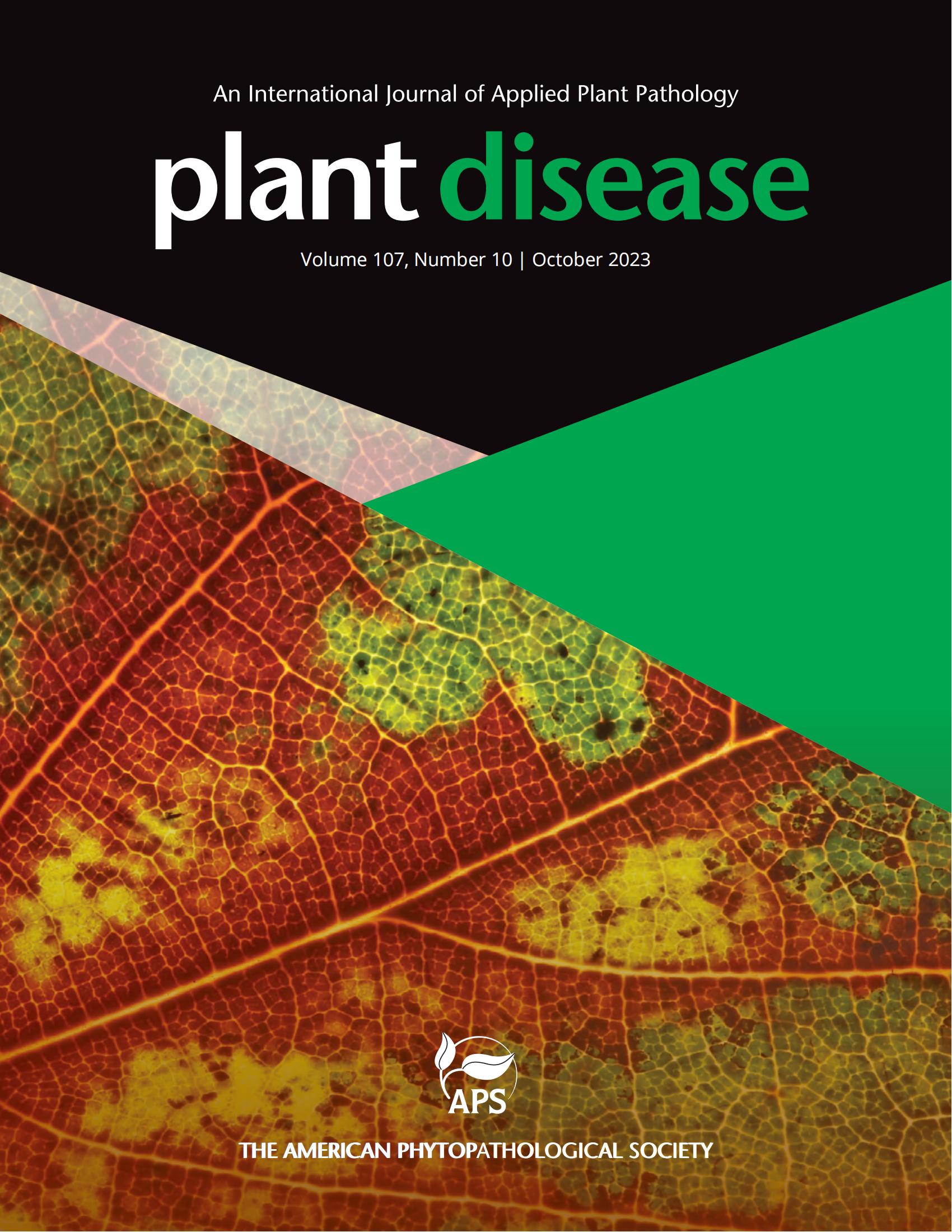美国及田纳西州引起香杉根腐病的植霉病初报。
摘要
香柏木[香柏木]佛罗林是一种针叶常绿树木,原产于北美西部,田纳西州正在评估它对美国东部景观的适应性。2024年5月,在田纳西州麦克明维尔苗圃研究中心的美国农业部研究地块上,在田间条件下生长的一岁香雪松幼苗出现了根腐病(图1a)。在植株根系中观察到深褐色的病变。25株植物中,病害严重程度为40%,发病率约为20%。有症状的根组织用70%乙醇表面消毒,用蒸馏水清洗2次。将根组织切片置于含有V8-PARPH的培养皿中,在24°C光周期中培养8小时。培养3天后,菌落呈白色辐射,菌丝呈菊花样生长。孢子囊近球形(直径15.67 ~ 20.08 μm, n=50),顶生,呈乳突状(图1b)。卵原体光滑,呈丝状至球状(直径15.04 ~ 25.14 μm, n=50)(图1c)。菌株(FBG7190和FBG7191)在Ghimire和bayal - gurel(2023)先前描述的特定生长条件下,根据形态特征(de Cock et al. 2015)鉴定为植物芽胞菌(phytoythium vexans)。为了进行分子鉴定,使用DNeasy PowerLyzer微生物试剂盒(Qiagen, MA)从V8-PARPH培养7天的分离株中提取总DNA。引物对ITS1/ITS4 (White et al. 1990)、NL1/NL4 (Baten et al. 2014)和cox - f / cox - r (Hudspeth et al. 2000)分别使用核糖体内转录间隔物(ITS)和大亚基(LSU)以及线粒体细胞色素c氧化酶亚基II (COXII)三种遗传标记对分离物进行扩增和测序。分离株FBG7190和FBG7191的ITS、LSU和COXII序列(ITS: PQ555196和PQ555197;LSU: PQ555203和PQ555204;COXII: PQ562063和PQ562064)分别与PQ050141、EF426541和GU133524完全相同。为了实现Koch的假设,对生长在3.8 L容器中的1年生香雪松进行了致病性测试。用分离株FBG7190和FBG7191(每个分离株5株)的病原菌浆液(两板7日龄培养物/升)淋接种植株(150 ml/株)(Panth et al. 2021)。用不含病菌的琼脂浆浸泡5株作为对照。研究在温室中进行,温度为21 ~ 23°C,相对湿度为70%,光周期为10 h,使用架空灌溉系统每天灌溉两次,每次灌溉2分钟。接种15 d后,所有接种植株的根部均出现深褐色病变。对照植株未观察到任何症状(图1d)。从接种植株中分离得到了与vexans形态特征相似的菌株,通过DNA测序证实其为vexans。据报道,有花樱桃、银杏、红枫和紫荆会引起根腐病(bayal - gurel et al. 2021, Liyanapathiranage et al. 2023, Panth et al. 2021)。据我们所知,这是美国田纳西州和美国首次报道的引起香杉根腐病的vexans。鉴定该病原体作为致病因子对于制定和实施有效的管理策略具有重要意义。Incense cedar [Calocedrus decurrens (Torr.) Florin] is a coniferous evergreen tree, indigenous to western North America, that is being evaluated in Tennessee for its adaptability to eastern U.S. landscapes. One-year-old incense cedar seedlings grown in field conditions in a USDA research plot at the Nursery Research Center, McMinnville, Tennessee, exhibited root rot in May 2024 (Fig. 1a). Dark brown lesions were observed in the root system of the plants. Disease severity was 40% of the affected area, and disease incidence was approximately 20% of 25 plants. Symptomatic root tissues were surface sterilized with 70% ethanol and washed twice with distilled water. Small sections of root tissues were placed in Petri dishes containing V8-PARPH and incubated at 24°C in an 8-hour photoperiod cycle. Colonies with whitish radiate and chrysanthemum flower-like mycelial growth patterns were observed within three days of incubation. Sporangia were subglobose (15.67 to 20.08 μm in diameter, n=50), terminal and papillated (Fig.1b). Oogonia were smooth, filamentous to globose (15.04 to 25.14 μm in diameter, n=50) (Fig. 1c). The isolates (FBG7190 and FBG7191) were identified as Phytopythium vexans based on morphological characterization (de Cock et al. 2015) under specific growth conditions as previously described by Ghimire and Baysal-Gurel (2023). For molecular identification, total DNA was extracted using the DNeasy PowerLyzer Microbial Kit (Qiagen, MA) from 7-day-old cultures of the isolates grown on V8-PARPH. The primer pairs ITS1/ITS4 (White et al. 1990), NL1/NL4 (Baten et al. 2014), and Cox2-F/Cox2-R (Hudspeth et al. 2000) were used to amplify and sequence isolates using three genetic markers, including the ribosomal internal transcribed spacer (ITS) and large subunit (LSU), and mitochondrial cytochrome c oxidase subunit II (COXII), respectively. The ITS, LSU, and COXII sequences of the isolates FBG7190 and FBG7191 (ITS: PQ555196 and PQ555197; LSU: PQ555203 and PQ555204; COXII: PQ562063, and PQ562064) were 100% identical to those of PQ050141, EF426541, and GU133524, respectively. To fulfill Koch's postulate, pathogenicity tests were conducted on 1-year-old incense cedar plants grown in 3.8 L containers. The plants were drench-inoculated (150 ml/plant) with a pathogen slurry (two plates of 7-day-old culture/liter) of the isolates FBG7190 and FBG7191 (five plants per isolate) (Panth et al. 2021). Five plants were drenched with agar slurry without the pathogen and served as a control. The study was conducted in a greenhouse maintained at 21 to 23°C and 70% relative humidity with a 10-h photoperiod and irrigated two times a day for 2 min using an overhead irrigation system. Fifteen days after inoculation, dark brown lesions developed in the roots of all inoculated plants. No symptoms were observed in the control plants (Fig. 1d). Isolates resembling the morphological characteristics of P. vexans were recovered from inoculated plants, and their identity was confirmed as P. vexans using DNA sequencing. Phytopythium vexans has been reported to cause root rot disease in flowering cherry, ginkgo, red maple, and redbud (Baysal-Gurel et al. 2021, Liyanapathiranage et al. 2023, Panth et al. 2021). To our knowledge, this is the first report of P. vexans causing root rot of incense cedar in Tennessee and the United States. Identification of this pathogen as the causal agent is important for developing and implementing effective management strategies.

 求助内容:
求助内容: 应助结果提醒方式:
应助结果提醒方式:


